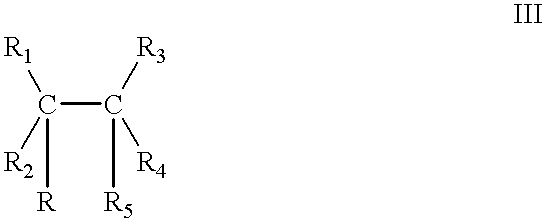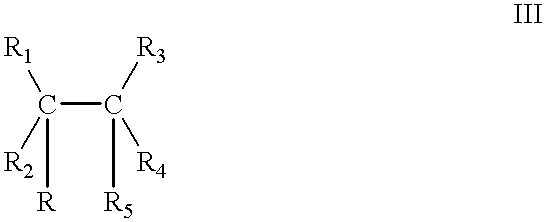Process for the preparation of saturated carboxylic acids and their esters
a technology of saturated carboxylic acid and esters, which is applied in the preparation of carboxylic compounds, carboxylic preparations from carbon monoxide reactions, organic chemistry, etc., can solve the problems of the loss of the efficacy of conventional catalyst systems, the failure of metal complexes which contain n-containing ligands,
- Summary
- Abstract
- Description
- Claims
- Application Information
AI Technical Summary
Benefits of technology
Problems solved by technology
Method used
Image
Examples
example 2
A 50 ml stirred autoclave was charged with the following reactants:
Styrene: 0.0144 mol
Catalyst of the formula Ia: 6.0383.times.10.sup.-5 mol
Methanol: 23.5 ml
The contents of the autoclave were flushed with nitrogen and then many times with carbon monoxide. Thereafter, the contents were heated to 75.degree. C. After the temperature is attained, the autoclave was pressurized with 50 psig hydrogen and then to 550 psig with carbon monoxide, stirring was started, and it was observed that gas absorption commenced immediately. For preparation of final methyl phenyl propionate product, the pressure in the autoclave was maintained constant using carbon monoxide and the progress of the reaction monitored by observing the pressure drop and by liquid sampling. The reaction was continued until the pressure drop was too low. The reactor was then cooled and the liquid phase analyzed by gas chromatography.
The GC analysis showed TOF of 40 h.sup.-1 and 95% conversion of styrene with a n / iso ratio of 1...
example 3
A 50 ml stirred autoclave was charged with the following reactants:
Styrene: 0.0144 mol
Catalyst of the formula Ia: 6.0383.times.10.sup.-5 mol
p-toluene sulphonic acid: 3.times.10.sup.-4 mol
Methanol: 23.5 ml
The contents of the autoclave were flushed with nitrogen and then many times with carbon monoxide. Then the autoclave was pressurized to 300 psig using ethylene and stirred well in order to saturate the solvent with ethylene gas and after saturation the pressure was kept at 250 psig. Thereafter, the contents were heated to 75.degree. C. After the temperature is attained, the autoclave was pressurized with 500 psig of carbon monoxide, stirring was started, and it was observed that gas absorption commenced immediately. For preparation of final methyl phenyl propionate product, the pressure in the autoclave was maintained constant using carbon monoxide and the progress of the reaction monitored by observing the pressure drop and by liquid sampling. The reaction was continued until the ...
example 4
A 50 ml stirred autoclave was charged with the following reactants:
4-methylstyrene: 0.0146 mol
Catalyst of the formula Ia: 6.0383.times.10.sup.-5 mol
p-toluene sulphonic acid: 3.times.10.sup.-4 mol
Methanol: 23.5 ml
The contents of the autoclave were flushed with nitrogen and then many times with carbon monoxide. Thereafter, the contents were heated to 75.degree. C. After the temperature is attained, the autoclave was pressurized to 500 psig with carbon monoxide, stirring was started and it was observed that carbon monoxide absorption commenced immediately. For preparation of final product, the pressure in the autoclave was maintained constant and the progress of the reaction monitored by observing the pressure drop, and by liquid sampling. The reaction was continued until the pressure drop was too low. The reactor was then cooled and the liquid phase analyzed by gas chromatography.
The GC analysis showed TOF of 60.3 h.sup.-1 and 85% conversion of 4-methylstyrene with a n / iso ratio of 1....
PUM
| Property | Measurement | Unit |
|---|---|---|
| Pressure | aaaaa | aaaaa |
| Angle | aaaaa | aaaaa |
| Substance count | aaaaa | aaaaa |
Abstract
Description
Claims
Application Information
 Login to View More
Login to View More - R&D
- Intellectual Property
- Life Sciences
- Materials
- Tech Scout
- Unparalleled Data Quality
- Higher Quality Content
- 60% Fewer Hallucinations
Browse by: Latest US Patents, China's latest patents, Technical Efficacy Thesaurus, Application Domain, Technology Topic, Popular Technical Reports.
© 2025 PatSnap. All rights reserved.Legal|Privacy policy|Modern Slavery Act Transparency Statement|Sitemap|About US| Contact US: help@patsnap.com



